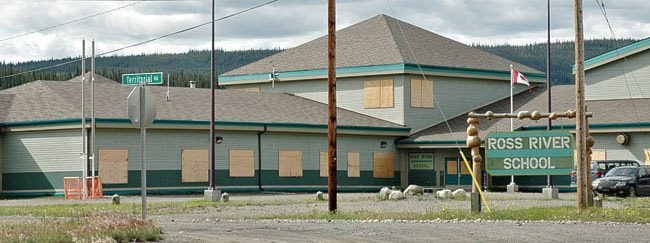UPDATED Jan. 21
Heavy snow, high winds or an earthquake could cause Ross River School to collapse, a new engineering report warns.
The structure is in “critical condition” according to the report from Stantec Consulting Ltd.
“In the event of major snow, wind and/or seismic load, we consider that the build’s structure may not be capable of resisting such loads and may become unsafe,” the report says.
“The unknowns surrounding the foundation and the subsequent superstructure problems are significant and should not be ignored.”
The report is what led to the school being closed indefinitely this week. It had already been closed and then opened again earlier this month.
The first sign of trouble was spotted on Jan. 9, when students and staff arrived at the school to find some big cracks in the walls. Everyone was sent home as a safety precaution.
By Tuesday classes were back up and running. Repairs were being planned for spring break and summer vacation. Officials said there was no need for alarm, the structural integrity of the school was not a concern, and the school was fit for occupancy.
The crack that was causing the most concern was not part of a load-bearing wall, a Public Works spokesperson said at the time.
Then the Stantec report came in and the doors were shut again this Monday.
As spokesperson Kendra Black tells it, the initial concerns caused the department to order a more complete once-over of the school. It was something that was scheduled to be done soon, but got pushed up, she said.
It’s not clear exactly how long the school has been unstable. Because the building is built on permafrost, it is monitored regularly, Black said.
The last report was done in December 2012, and didn’t identify these problems, she said.
Melting permafrost under the school, built in 2000, has led to movement.
It’s fixable, the report says, but would require “extensive work.” The extent of the damage means it’s not possible to estimate costs yet.
The Stantec report is 19 pages long, with many of those pages filled with pictures.
The majority of the problems are in the foundation or resulting from foundation problems, the report says. It talks about loose bolts and significant movement of some of the piers in the foundation.
The floor is sloped, particularly around the perimeter of the building. Walls and windows are cracking.
At the time of investigation, the temperature in the school’s crawl space was 17 degrees. According to the engineers that is “extremely high” for a building with the type of foundation found at Ross River School.
Crawl spaces would normally have temperatures that are the same as the outside air.
“High temperatures in the crawl space are considered to be the major cause of the permafrost degradation under the building,” the report says.
There is air handling equipment in the crawl space that needs to be kept from freezing, Black said.
Insulating the area was a recommendation from an earlier report. The installation was designed as a barrier to prevent the heat from escaping into the permafrost.
According to the latest report, the crawl space was insulated with 100 millimetres of spray foam in 2013.
The engineers recommend the crawl space be left unheated.
Department of Education spokesperson Ronuk Modha said government officials were in Ross River to meet with chief and council, school officials and community members to decide what to do.
A community meeting happened last night.
This morning, Modha said the meeting went well and the department gathered a lot of feedback, but no plan has been finalized yet.
Education has said the first choice would be to find other buildings in Ross River that could be used to hold classes. Ross River School has about 50 students, from Kindergarten to Grade 10, and about 17 staff.
If that doesn’t work, Modha said Monday the department might look into shipping temporary facilities into the community.
“Another option that has been identified is whether or not there’d be an appetite to transport the students to the school in Faro,” Modha said.
All the Ross River students could probably fit into the school, he said.
“We don’t want to make any decision at this point without getting the input from the community. So that’s our number one priority.”
Modha would not say how long it might be before the students get back to class.
NDP education critic Jim Tredger criticized the government for lacking a contingency plan for what to do with students in a situation like this.
“We’ve known that not only is it on permafrost, but there’s problems, the building’s shifting. They’ve spent a fair bit of money trying to correct it and put different things in. But in the back of your mind you got to have a ‘what if’ and it doesn’t appear to be there,” he said.
Along with the public school, Yukon College has also been shut out of its campus. The college shares the same building as the school.
Spokesperson Michael Vernon said the college is working on finding alternative washrooms for the 13 students and two instructors who are part of the two heavy equipment technician programs running in the mobile trades training trailer.
Campus staff hope to find a new location for a three-and-a-half-day course on bulk water delivery scheduled for this week.
After that’s found, the co-ordinator will start looking for a new home for the Kaska language course, which runs Monday and Tuesday evenings, Vernon said.
She’ll also be looking for new locations for a trapping course set to run from Jan. 28 until Feb. 1, a knitting course set to run Jan. 21, 27 and 28, and a drum-making workshop set to run in early February.
Contact Ashley Joannou at
ashleyj@yukon-news.com
